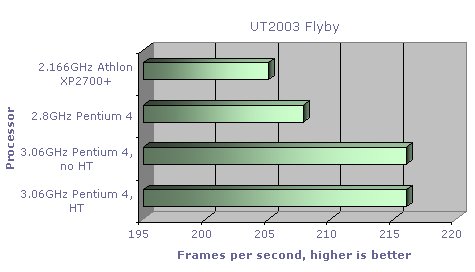|
Some SETI action before we move onto the game tests. XP2700+ thunderous FPU performance and the assistance from low latency DDR on nForce2 managed to grab it top spot when we looked at the 2.8GHz Pentium 4. Will HyperThreading or the extra 266MHz manage to give the 3.06GHz top spot here?
 More CPU scaling and a nice HT benefit yet again
More CPU scaling and a nice HT benefit yet again
Not quite enough to give this new processor the lead in our SETI benchmark list but we are seeing consistent CPU scaling from the extra MHz and also a decent benefit from allowing more efficient use of CPU resources from HyperThreading and thread dispatch.
So we've seen so far that in subsystem limited tests that HyperThreading generally has a small performance boost for the tasks we do and we are also reaping the benefits from a 3066MHz base clock. Will this carry on to 3D games performance?
We'll look at the fans favourite first, 3DMark 2001SE from the MadOnion.com guys.
 More CPU scaling and our small HT benefit
More CPU scaling and our small HT benefit
I wasn't expecting a result quite like this when I first sat down to write this review and benchmark the system. I was expecting a slightly higher non-HyperThreading result and this can maybe be put down to differences between the Gigabyte board the 2.8GHz processor was used on compared to the Intel D850EVM2 used for the 3.06GHz chip. The other susprise was the benefit from HyperThreading since I wasn't expecting to see any at all and maybe even a small loss.
Something to think about as we move on to UT2003, both Botmatch and Flyby results. Botmatch is subsystem and CPU limited and the Flyby is tied to graphics card performance. Let's look at the Botmatch results first.
 More CPU scaling and our small HT benefit, again!
More CPU scaling and our small HT benefit, again!
Again, more performance from CPU scaling eclipsing the XP2700+ and 2.8GHz P4 results and our tiny HyperThreading increase for the same reasons we've discussed before.
 CPU scaling but this time a small decrease with HyperThreading
CPU scaling but this time a small decrease with HyperThreading
It's not a mammoth decrease but it highlights the fact that HyperThreading isn't a performance win in all cases. This is the type of result I expected to see with 3DMark 2001SE. Games tend to utilise tight loops and a strict set of specific CPU instructions (for doing geometry and physics calculations using the math units on the CPU) so HyperThreading isn't able to offer us much of a speedup if any at all.
|